Cleaning horse saddles is an essential skill has a horseback rider. In fact, you should know how to clean all of your tack. But in this post, I’m going to focus on how to clean a saddle and get it shining like new again.
Not only does a clean saddle simply look a lot nicer – something you might need if you’re showing – but it’s going to increase the longevity of your saddle significantly.
Leather saddles especially will dry out, weaken and then start to crack when they aren’t maintained properly. Although synthetic saddles are very much designed to take all of that dirt and moisture much more gracefully, you still want your saddle to look black if it was originally black!
P.S. For more info on how to clean ALL of your tack, click here.
It’s all covered here: English or Western, leather or synthetic

Whether you ride English, Western or something in between, I’m going to go through an easy and quick routine that works every time to get out all of that dirt and grime.
Also, I’m going to tell you some tricks that will help your saddle become softer and look much newer than it has in a while.
Furthermore, even if you use a synthetic saddle because you’ve realized the damage leather saddles acquire when they aren’t cleaned properly, I’ll go through how to clean these as well!
Obviously this isn’t quite as vital but even a synthetic saddle doesn’t look great when it’s all dirty and gross. Plus it’s better for your horse and you if you’re using clean tack (and other accessories too!)
How to clean a saddle: Regular cleaning is the solution to all your problems
A common problem is leather saddles drying up, becoming hard and then cracking. I mean, without intervention, this is inevitable. The leather is slowly being damaged from the combination of the moisture and dirt that it’s continuously exposed to.
A common problem I see is riders ignoring this slow decline. Then once there’s already been a pretty significant of damage, they spend hours trying to clean and salvage their saddle. This just isn’t the way to do it.
I know it can be annoying and I probably sound like your mother but you need to get into a routine of cleaning your saddle. The more often you clean it, the less time it will take per cleaning and your saddles will last you so much longer! In the long run, you’re saving time and money by just getting into this routine as soon as possible.
I would say that you should be cleaning your saddle for every 15-20 rides or every month – whichever comes first. So if you’re riding much more than 15-20 times a month, clean your saddle after that number of rides and if not, then clean it monthly.
If you have a synthetic saddle, then there’s not really a time limit. But just for the sake of keeping it clean and preventing you and your horse from getting dirtier than you need to, I would say every 30 rides or once every 2 months, whichever comes first.
The step by step guide to how to clean a saddle – for leather saddles
What you’ll need:
- A stand, rail on somewhere where you can securely rest your saddle (not your horse!)
- Saddle soap or a leather cleaner
- A bucket with warm water
- A sponge
- A cloth
- Small brushes (a new, hard toothbrush will do fine)
- Metal polish (optional)
- Leather conditioner and/or oil (optional)
- A fleece cloth (optional)
- Loud, up-beat music (optional but definitely more fun!)
Step 1) Sponge wipe-down
First you want to dip your sponge in your bucket of warm water and wring it out until it’s damp. Then go over your entire saddle. You just want to wipe off all of the superficial dirt and grime off the saddle.
Also, by wetting the saddle, you’re opening the pores of the leather and makes the leather more receptive to the saddle soap. Think of it like you have to rinse in the shower before you add soap to make it sudsy. If you didn’t, the soap wouldn’t clean properly.
Step 2) Saddle soap
Next you want to apply some of the saddle soap, detergent or leather cleaner to your sponge. If it’s a hard soap or saddle detergent, then you’ll have to scrub a little bit harder. If it’s a leather cleaner or liquid soap, then it’s generally more “self-cleaning.”
Of course, you’ll also have to scrub less depending on how often you clean your saddle!
If you’re looking for a good hard soap, I recommend Fiebing’s Yellow Saddle Soap. For a liquid soap, I’d go for Farnham Leather New Saddle Soap.
Either way, you should only clean small areas at once. I like to start at the back top and work my way down one side and then all the way down the other. It’s just logical to me to work from the top down but you don’t have to do it this way. As long as you’re doing it one area at a time and you aren’t trying to scrub the whole saddle at once, you’re good.
Make sure that you take all removable leather parts off your saddle and clean them as well (depending on the type of saddle you’re cleaning). Also, you want to get beneath all of the flaps and into the little nooks and crannies – even if it’s annoying. This can be especially difficult with a sponge and sometimes it’s just ineffective, so…
Step 3) The toothbrush clean
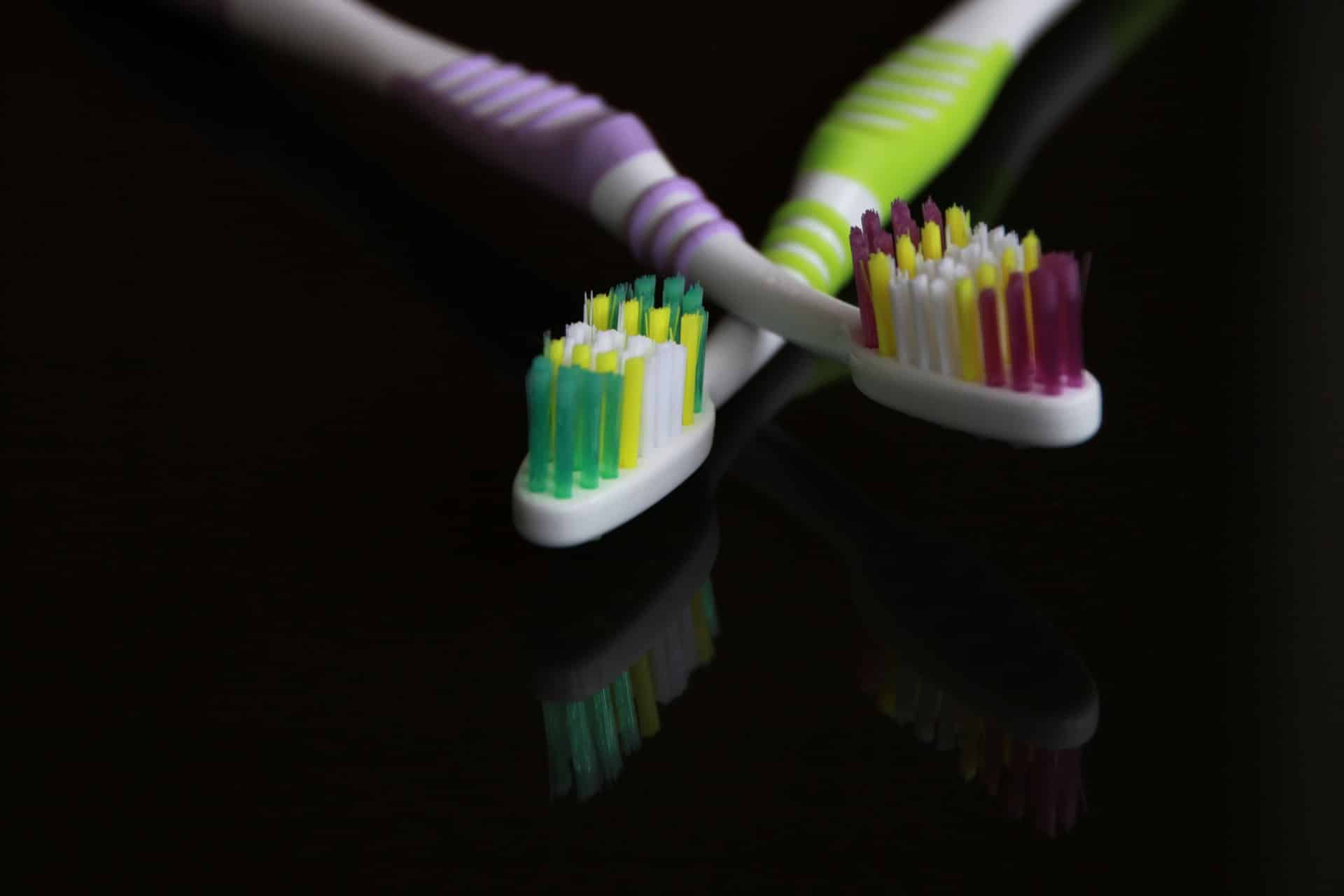
In those little, hard-to-get areas of your saddles that’s where a little brush comes in handy. A toothbrush works very well for this. Especially around the little leather loops and up under the saddle flaps.
You want to work the toothbrush in small circular motions on the leather. This will work the saddle soap deep into the leather and help all of the dirt stuck in there come out.
The toothbrush is also just useful for areas on the top of the saddle that are very dirty and have stubborn spots.
Sometimes no matter how hard you scrub with a sponge, you just won’t be able to get the dirt out if it’s too deep.
Make sure you’re only scrubbing regular leather with a brush, however! Read below under “Is there a difference between English & Western saddles” for more details.
Step 4) Wipe it down
After your saddle is all soaped up, you want to take your cloth and wipe the whole thing down. I don’t like using a hose here although some people do that. It just makes me nervous soaking the leather to that extent – it seems like it’s too much moisture.
I prefer just taking a damp cloth that I’ve wrung out and wiping from top to bottom. But you can do whatever works for you to get all of the soap off. Just make sure all the soap is off.
Sometimes, once you’ve done this, you’ll realize that there’s still some spots here and there that you missed. Just repeat Step 3 if this happens with a little bit of soap on your brush and scrub the spots. Then wipe down again.
Step 5) Shine it up (optional)
This step is optional – I mean you’re saddle is all clean now – but it will help your saddle look much newer and last longer. You want use the leather conditioner to restore the flexibility and suppleness to your saddle. It will also protect your saddle from moisture and help it keep from eventually drying out and cracking.
The saddle soap is like shampoo and the leather conditioner is like hair conditioner. Without conditioner, your hair gets dry, brittle and weak much faster.
For this step you need the fleece cloth. For the big areas, just spray the conditioner right on the leather and use the fleece to work it in. Again, do small areas at a time. For the smaller, harder-to-reach areas just spray it on the cloth and then work it into the leather.
Similarly, you can finish everything off using some leather oil. This is a little different than the conditioner because it’s primarily for restoring that original darker color to your saddle and restore shine.
There’s some areas you don’t want to cover with this. Again, read below under “Is there a difference between English & Western saddles” for more details.
Step 6) Don’t forget the non-leather bits!
Depending on if you have a Western or English saddle, you’ll have more or less non-leather components to your saddle. Most of these will be metal such as the stirrups. For these, you can use the damp cloth to simply wipe them down.
If you’re prepping for a show or something, then you may want to also polish them off using another fleece cloth. Usually polishes will come with their own specialty cloths as well.
Remember, don’t spray any metal polish because it might get on the leather. Spray it on the cloth and then use the cloth to polish.
Is there a difference between English & Western saddles?

Western saddles tend to be larger, fancier and more embellished than English saddles. You’re going to have more small little pieces and attachments for a Western saddle.
At the end of the day, leather is leather. Chances are a Western saddle will simply take a longer time to clean. What you need to worry about is if there’s non-leather areas. You’ll mostly find these on Western saddles but even English saddles will have areas of suede sometimes.
For these areas you want to be extremely gentle. Suede or roughout leather can not be scrubbed with a toothbrush because it will lift areas off and leave bare patches. So you have to be extra gentle when cleaning these areas. A trick that you can use if these parts of your saddle are very dirty is adding a small amount of cornstarch and then gently using the toothbrush to flick/brush it away.
Furthermore, you can’t use saddle conditioner on these areas because they’ll change texture. Similarly, don’t add any oil on them either because they’ll discolour.
The step by step guide to how to clean a saddle – for synthetic saddles
What you’ll need:
- A stand, rail on somewhere where you can securely rest your saddle (not your horse!)
- Synthetic saddle cleaner or detergent
- A bucket with warm water
- A sponge or a cloth
- A small soft-bristled brush (a soft toothbrush will do fine)
- Metal polish (optional)
- Loud, up-beat music (again, optional but definitely more fun!)
Step 1) Sponge wipe-down
Just like with leather saddles, you want to dip your sponge in your bucket of warm water and wring it out until it’s damp. Then go over your entire saddle. You just want to wipe off all of the superficial dirt and grime off the saddle.
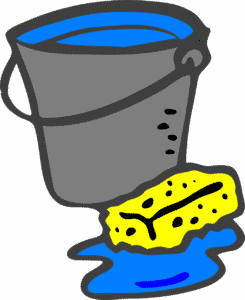
Step 2) Saddle cleaner or detergent
Next you want to spray some of the saddle cleaner on the saddle. Scrub small areas at a time, just like with a leather. You’ll also have to scrub less depending on how often you clean your saddle!
I like to start at the back top and work my way down one side and then all the way down the other. It’s just logical to me to work from the top down but you don’t have to do it this way. As long as you’re doing it one area at a time and you aren’t trying to scrub the whole saddle at once, you’re good.
Make sure that you take all removable parts off your saddle and clean them as well. Also, you want to get beneath all of the flaps and into the little nooks and crannies – even if it’s annoying. This can be especially difficult with a sponge and sometimes it’s just ineffective, so…
Step 3) The toothbrush clean
In those little, hard-to-get areas of your saddles that’s where a little brush comes in handy. A toothbrush works very well for this. Especially around the little loops, up under the saddle flaps, etc. For a synthetic saddle, however, I would use an especially soft-bristled brush.
You want to work the toothbrush in small circular motions. This will work the cleaner deep into the material and help all of the dirt stuck in there come out.
The toothbrush is also just useful for areas on the top of the saddle that are very dirty and have stubborn spots. Sometimes no matter how hard you scrub with a sponge, you just won’t be able to get the dirt out with that if it’s too deep.
Step 4) Wipe it down
After your saddle is all soaped up, you want to take your cloth and wipe the whole thing down. I don’t like using a hose here although some people do that. It just makes me nervous soaking the the material to that extent – it seems like its too much moisture, even if it’s not leather.
I prefer just taking a damp cloth that I’ve wrung out and wipe from top to bottom. But you can do whatever works for you to get all of the soap off. Just make sure all the soap is off.
Sometimes, once you’ve done this, you’ll realize that there’s still some spots here and there that you missed. Just repeat Step 3 if this happens with a little bit of soap on your brush and scrub the spots. Then wipe down again.
Step 5) Don’t forget the non-leather bits!
Depending on your saddle design, you’ll have more or less non-leather components to your saddle. Most of these will be metal, such as the stirrups. For these, you can use the damp cloth to simply wipe them down.
If you’re prepping for a show or something, then you may want to also polish them off using another fleece cloth. Usually polishes will come with their own specialty cloths as well.
Remember, don’t spray any metal polish, because it may get on the saddle’s material. Spray it on the cloth and then use the cloth to polish.
Cleaning horse saddles is quick & easy if you do it regularly
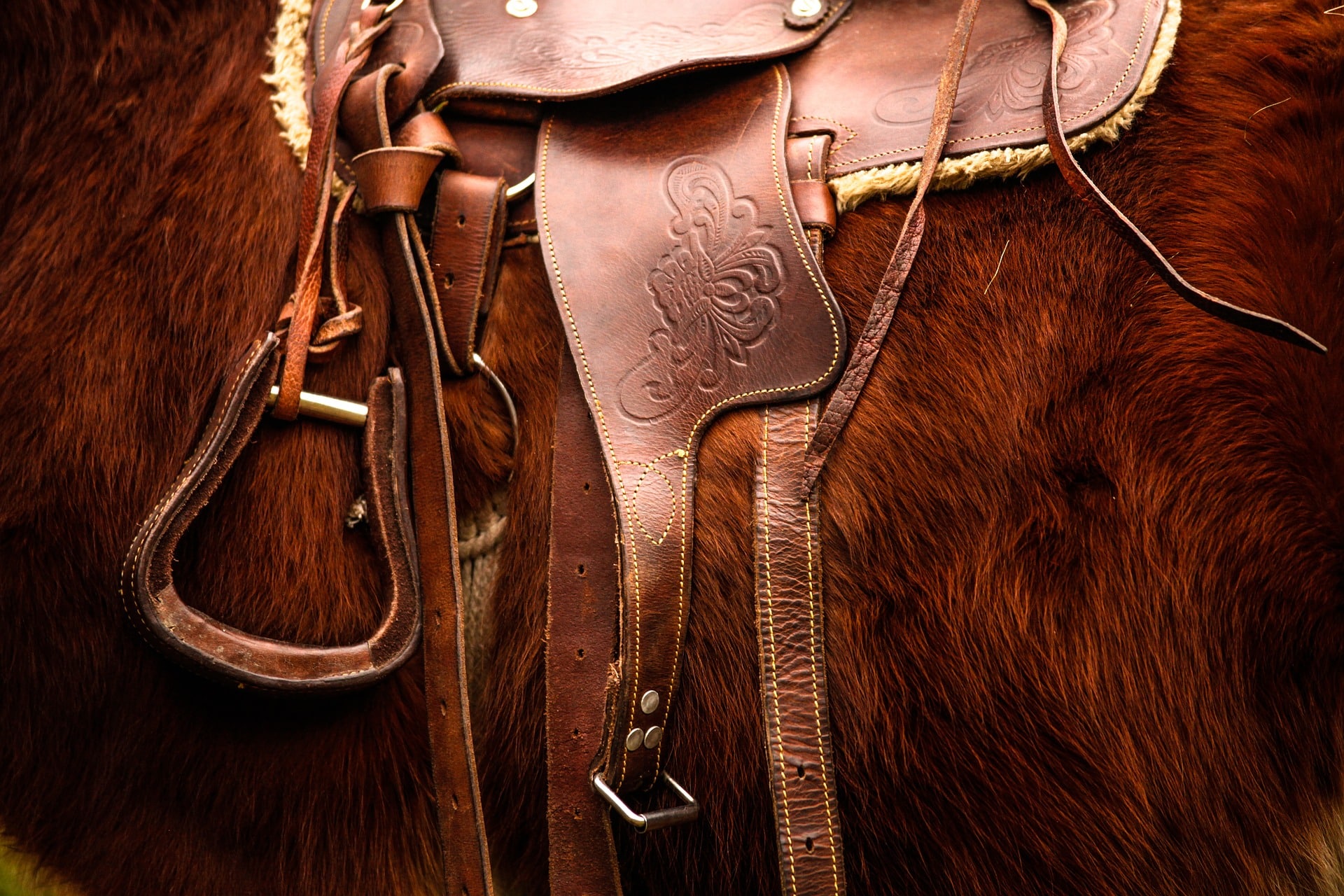
It can be a pain to scrub and scrub and scrub but this is just what’s going to happen if you keep procrastinating cleaning.
You just need to suck it up and do it at least once a month for leather and every two months for synthetic.
This way, it’s a much quicker and easier process. You’re just doing your regularly scheduled tack maintenance rather than trying to reverse damage done. And that really makes all the difference.
Give me a shout in the comments below if you have any questions or concerns when it comes to saddle cleaning!
Happy riding 🙂
Liked this post? Why not pin it!
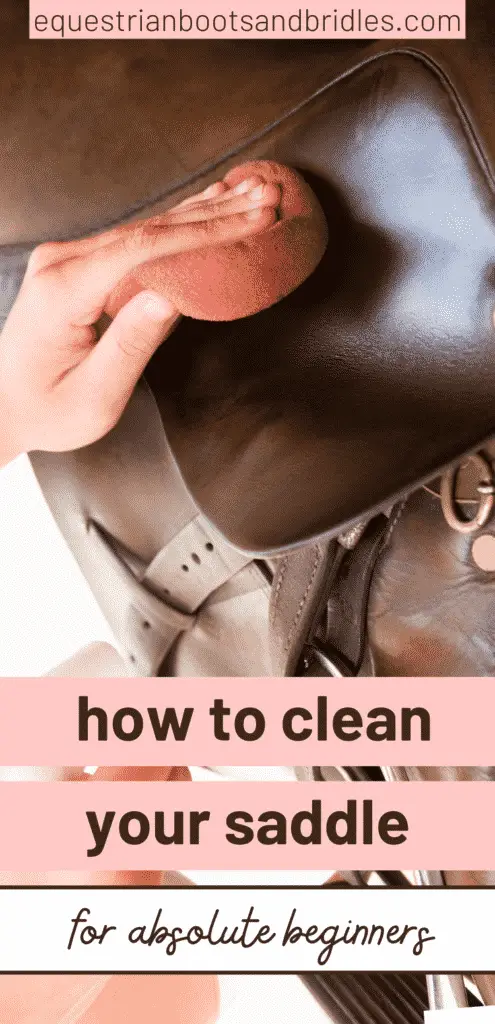

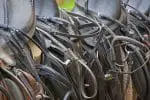
Hi Martina,
Your post is very detail oriented, which is awesome since now I feel like I know exactly what to do when it comes to cleaning my saddlery. I like it when you break down each step and tell people exactly what to do and what the difference is between a Western and English saddle – I only ride English right now. I know this is random but I am just curious if they have a mold for the saddle since it is shaped in away so that it will wrap around a horse’s back?
Hey Kien,
I’m so happy you found my post helpful. Definitely let me know if you have any questions about cleaning saddlery or any other tack for that matter.
And yep there’s a mold – it’s called a “tree” and the leather of the saddle is formed around it. The shape of the tree determines the fit that the saddle will have on the horse’s back. As you know all saddles also have a girth, which is just a leather strap. This is what wraps underneath the horse’s belly and really keeps the saddle in place.
But it’s definitely important to have a saddle that will fit your horse well regardless. Some horses have bony withers and a thiner ribcage whereas some horses and lots of ponies will have a much rounder girth. Different saddles will fit these types of horses differently.
Hope this answered your question,
Martina
I love the font of your title! It’s so… elegant and its very fitting for your subject.
Wow, this is a very thorough walk-through. Great job and thank you! You really broke everything down and did not leave any room for confusion.
I don’t know very much about horses and have never owned one but have been very fascinated by them for awhile.
Hey Kayla,
Thank you so much for your positive feedback on my site. That’s really nice of you to say. Also I’m glad that you thought it was a thorough walk through of how to clean a saddle and that you learned something from it.
Are you thinking of starting horseback riding perhaps? I would strongly recommend looking into it if you haven’t yet and if horses interest you. 🙂
Don’t hesitate to contact me if you have any further questions
Cheers,
Martina